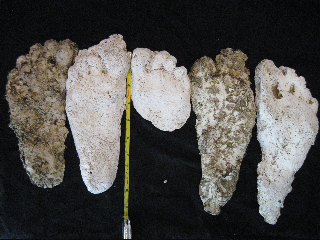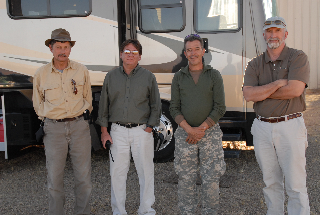Sierra Sasquatch: What Did You Think?
Posted by: Loren Coleman on March 17th, 2010
This week’s MonsterQuest episode has now screened, and it was a return to Sasquatch territory. It is actually MQ’s last episode to be produced (even though the penultimate to air). What did you think?
Boy, that one guy sure could track!


This episode looked at the possibility of family units of Sasquatch. One researcher, Jamie Avalos, has encountered a number of prints and made track casts (images above, courtesy of Jamie Avalos) and while smaller than the average Sasquatch print, Avalos suggested that these may represent evidence of juvenile Sasquatch. Avalos interview found here.

Accompanying Avalos on this exploration was Dr. Jeff Meldrum (at right) of Idaho State University, who joined in the search for new evidence and compared the tracks as well as food sources.
Rounding out the team, was a special appearance by wildlife consultant and biologist John Mionczynski (at left, who appeared in the pilot episode for MonsterQuest, “Giganto: The Real King Kong”). John took a realistic approach, detailing how the prints are well within the range of humans.
In addition to an expedition, fresh new video evidence (from 1991) taken by family who were alongside Mono Lake, California was analyzed. The analysis was performed by Stutchman Forensic Laboratories.
MQ pre-released on YouTube for Cryptomundo the short clips that show the original footage, and the one which has been stabilized by Stutchman Forensic Laboratories.
http://www.youtube.com/watch?v=9mR0hiDPpYY
http://www.youtube.com/watch?v=jIOCpUMp0lY
Maybe it is not too late to Save MonsterQuest?
My sincere thanks to exclusive information from MQ Executive Producer Will Yates regarding the March 17th episode!
Update: The above videos no longer exist on YouTube. See the videos below for reference:
This episode looked at the possibility of family units of Sasquatch. One researcher, Jamie Avalos, has encountered a number of prints and made track casts and while smaller than the average Sasquatch print, Avalos suggested that these may represent evidence of juvenile Sasquatch.
Accompanying Avalos on this exploration was Dr. Jeff Meldrum (at right) of Idaho State University, who joined in the search for new evidence and compared the tracks as well as food sources.
Rounding out the team, was a special appearance by wildlife consultant and biologist John Mionczynski. John took a realistic approach, detailing how the prints are well within the range of humans.
In addition to an expedition, fresh new video evidence (from 1991) taken by family who were alongside Mono Lake, California was analyzed. The analysis was performed by Stutchman Forensic Laboratories.
About Loren Coleman
Loren Coleman is one of the world’s leading cryptozoologists, some say “the” leading living cryptozoologist. Certainly, he is acknowledged as the current living American researcher and writer who has most popularized cryptozoology in the late 20th and early 21st centuries.
Starting his fieldwork and investigations in 1960, after traveling and trekking extensively in pursuit of cryptozoological mysteries, Coleman began writing to share his experiences in 1969. An honorary member of Ivan T. Sanderson’s Society for the Investigation of the Unexplained in the 1970s, Coleman has been bestowed with similar honorary memberships of the North Idaho College Cryptozoology Club in 1983, and in subsequent years, that of the British Columbia Scientific Cryptozoology Club, CryptoSafari International, and other international organizations. He was also a Life Member and Benefactor of the International Society of Cryptozoology (now-defunct).
Loren Coleman’s daily blog, as a member of the Cryptomundo Team, served as an ongoing avenue of communication for the ever-growing body of cryptozoo news from 2005 through 2013. He returned as an infrequent contributor beginning Halloween week of 2015.
Coleman is the founder in 2003, and current director of the International Cryptozoology Museum in Portland, Maine.










I do believe that was a “black” bear. The technical term is black, but they range into the browns of every shade. That one is walking like a bear. I would figure Mono Lake a little too busy for the big guys.
If that was a bear, what was it attacking? I don’t know that they get up on two feet for any other reason. The clip was sooo short, there isn’t a valid bit of evidence in it. As far as being too busy, downtown Aberdeen, Wash has vocalizations (according to BFRO) in creek bottoms thru out town
It’s possibly a bear but I don’t think so. The arms appear to hanging down but I wonder about their length? It’s a good blobsquatch photo though.
Bears do stand for other reasons, including to get a better view of things. Mono Lake is just to the East of the Sierra Nevada mountains, where I have seem black bears numerous times over the last 40 years or so. In Mammoth Lakes California, very close to Mono Lake, black bears are practically ubiquitous.
i have been following Jaimes work for about a year now. I feel he does good work. He has a different style. Pretty much the Ninja of Sasquatch researchers. He’s always prepared. I will be watching this. And Thanks Loren for posting this. I love the topics and how the people here write. Question Loren? Is this the last episode of the season or the last of MQ?
It looks more like cousin it, than a bigfoot.
A good but not great episode. I have seen better. I did enjoy seeing Meldrum, Mionczynski and Avalos, and the things they found were interesting, but it looks like MQ is going out with a whimper instead of a bang. Too bad. Oh, well, there’s always Destination Truth and the new BFRO series when it debuts.
Aside from enjoying Jeff Meldrum and the awesome tracker guy, I saw the same things that unfortunately are IMO reasons MQ won’t make it.
They keep doing the same stuff over and over.
1. The aerial recon or what I like to call “filler”:
Why do we need to see the failed test flight? Why did we need to see any flight for that matter? The aerial thing encountered problems, sound familiar? How many MQ episodes has the plane or helicopter encountered problems? Why didn’t they just mention that they tried aerial recon and it didn’t work? We didn’t need to see it!
2. Creature was between 6 and 8 ft tall. Wow! Could that have sounded any worse?
3. MQ jumps from location to location and never stays long enough to really resolve anything. Why oh why didn’t MQ concentrate on the cabin from the two parter they did last season? I would have paid to have someone at that cabin at all times with equipment for at least 3 months.
4. No dedicated team. Each time it’s a different group on the ground searching. If they used the same team every time I really think it would improve technique and methodology. Not sure THC would want to pay a dedicated team though. Especially when they don’t concentrate on the same cryptid every week. However, if they did concentrate on Sasquatch every week I’d watch.
The loner guy likely had human casts and Jeff all but proved that IMO. Jeff bringing his casts made this part of the show a success. I did like that the loner guy spent all that time tracking Sassy’s on his own. I did respect his effort and IMO his concentrating on that area may well pay off.
Again I think having Jeff on the ground and involved with the actual search was the best thing MQ has done in 5 years.
If it weren’t for the perpetual bad habits the show might survive. Frankly they could have done all the pertinent info easily in half an hour.
I like the show. MQ started out promisingly enough but has never really delivered, so I tend to agree with Raisinsofwrath.
Destination Truth goes to really great locations but treats them all like three day weekends. What really hurts DT is when the team members, usually led by Josh, go running wildly after a ‘thing’ in the dark.
I’d like to see Jeff Meldrum get the kind of funding DT gives Josh for globe trotting.
Greetings,
I enjoyed the episode and as raisinsofwrath stated MQ might have done a better job but there’s always the budget.
However, he did mention the one thing I noticed and have photographs about on our site at http://www.sierrasquatch.net. We’ve found the adult prints at Pollock Pines in several places and some possibly juvenile prints.
South of the town of Kyburz off US 50 we discovered a fresh print of an apparent juvenile and what my partner Bob interpreted as a body print.
It raises the same question Professor Meldrum brought up in the episode. Why are we finding regular adult footprints mixed in with prints that might be human or might be juvenile Sasquatch?
I believe Avalos is right and the Sierras are home to at least one migrating family group but I think it’s many more. The answer to the above question might be the species when young with little weight has a human type arch in the foot of the young. As the juveniles age into adulthood and gain weight the foot flattens out into what we usually find and associate with the species.
This hypothesis would explain the finding of different types of prints and would be an interesting evolutionary adaptation. The idea may or may not be correct and I won’t be upset if everybody says no way.
However, please remember this is an unknown species and anything is possible.
In the meantime it looks like the end of the road for MQ. My best,
One question that probably should be answered, and I suspect the answer pretty much kills the “migrating sasquatch family” theory:
Given what we know about primate growth rates —
Why has the “juvenile” print not changed size in 3 years of tracking?
Another question, and I wished Meldrum had asked & answered:
Is having an arch compatible with having a mid-tarsal break?
Again, I’m no expert, but it would seem that the two were mutually exclusive.
i liked it but you know they talk to much about big foot on it make way for more cryptids
“It raises the same question Professor Meldrum brought up in the episode. Why are we finding regular adult footprints mixed in with prints that might be human or might be juvenile Sasquatch?”
~~~~~~~~~~~~~~~~~~~~~~~~~~~~~~~~~~~~~~~~~~
to comment on the obvious ….. in order for there to be adult BF’s there have to be little ones to grow up to be the adults . ive often thought it odd that juvinile BF prints are rarely ever mentioned , but most likely the would just be dismissed as barefoot humans . it doesnt seem likely that a little foot could mature into an adult big foot in just a year or two like most other big critters we are familiar with in the USA , so family groups seem likely to me . since most sightings seem to be reported as adult males maybe the males scout ahead of the rest sometimes to keep the rest of the family from being suprised by predators , or to intionally direct attention away from the rest of the group .
also , maybe some BF’s like following these strange creatures (humans) that come into their neighborhood to see what they are doing and see if they are a threat .